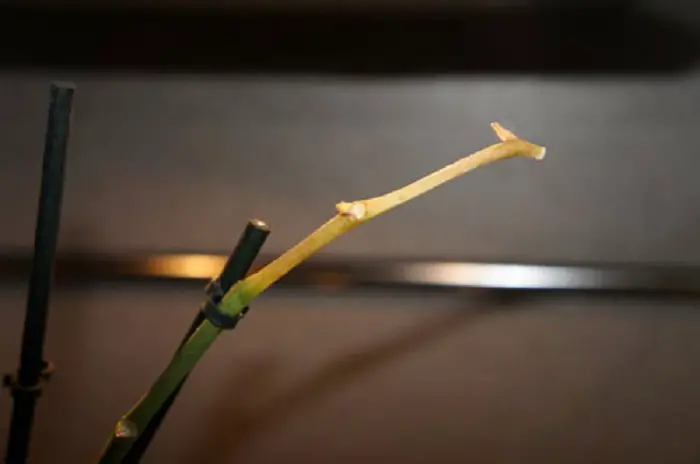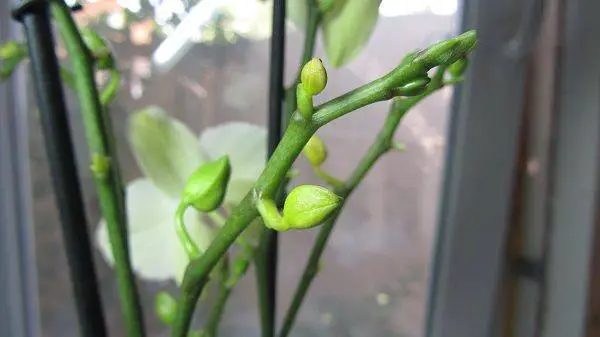The problem of orchid stem dried out, as well as how to solve it, is one of the most important issues in the care of phalaenopsis.
Living plant stems or in orchid flower spikes are an indicator of proper development and quality care. If dry areas appear on the stems, they must be urgently removed.
The next step after the removal process should be to eliminate exotic pet care mistakes. Otherwise, the presence of dry flower spikes, combined with improper care, can lead to problems in the development and flowering of exotic.

orchid stem vs spike
A spike is a formed flower stem that is able to release arrows and bloom. In addition, children can sometimes form on the stem, that is, the so-called independent processes, with which the orchid can be planted.
The period of formation of a flower-bearing arrow usually takes from one to three months, after which the orchid begins the flowering period. The duration of this period can vary from 2-3 months to six months, subject to proper care, as well as high-quality watering of the plant.

It is also worth noting that not all orchids are able to bloom. Often, flowers can please only adult specimens of the plant, which have formed a good root system. Young orchids under the age of one year, as a rule, still do not have enough vitality to support the flowering process.
Orchid Flowering time
The natural duration of orchid flowering under favorable conditions should be at least three months. The maximum period of this period can be up to 6-7 months.
In order for the exotic to actively bloom, it needs to create comfortable conditions :
- adhere to light and thermal conditions;
- create comfortable air humidity around the flower;
- avoid overheating and drafts;
- observe other important nuances.
Phalaenopsis daylight hours in natural conditions is at least twelve hours. If we are talking about home maintenance and care, then in the spring and summer, the plant has enough daylight.
At the same time, in autumn and winter, when daylight hours are waning, this problem has to be solved with the help of additional artificial lighting. To do this, you need to purchase a special fluorescent lamp in a flower shop.
The full development of the flower is also possible at a comfortable temperature and humidity. The temperature regime of an orchid can range from +18 to +25 degrees. If the exotic has stopped blooming, you can create artificial stress for it by lowering the temperature (for example, take the plant to the balcony).
IMPORTANT! When artificially creating a stress factor, the main thing is not to overdo it. The lowest possible temperature should not be less than + 16 degrees.
Since the tropics are the natural habitat of orchids, air humidity of 70% is quite comfortable and acceptable for them. But at the same time, orchids feel quite comfortable at a humidity of 50%. For their comfortable existence in a temperate climate, the humidity of the environment should not be below 50%.
For growing orchids, it is necessary to adhere to certain temperatures and humidity.
Check out the solution for White Sticky On Orchids.
Why orchid stem dried out?
There are several varieties of drying stems. The reasons that contribute to this may be of a different nature. The degree of damage done can be determined by the appearance of the orchid stem dried out.
At different periods of the orchid’s life, gardeners can observe its drying. In some cases, this is a normal aspect of development, but in most cases, a dried stem is an indicator of lack of care. Experts distinguish several main types of orchid dried stem:
- dry top of the stem;
- completely dry stem;
- sluggish orchid leaves and yellowed bottom of the stem.
The dry top of the stem most likely indicates that the exotic has recently faded. In this case, it is enough to simply cut off the dry section of the stem and the plant will fully develop again. In other cases, a dry stem is a signal that something needs to be changed.
Causes of orchid stem dryring out
There may be several main reasons why the stem fades. Among the main ones are :
- overheat;
- hypothermia;
- insufficient or excessive watering;
- lack of fertilizers;
- improper introduction of dressings and others.
Not only do the stems suffer from overheating, but also very often the root system of the flower. Most often, orchids are subject to high temperatures in the spring and summer.
In order to avoid disastrous consequences for a green pet in hot weather, it is necessary to protect a tropical flower from constant direct sunlight. To do this, for example, a homemade opaque tablet can be placed between the glass and a plant, as well as moisten the environment using pallets of water.
In addition, it will not be superfluous to cover the batteries and other heating elements nearby with wet towels.
CAREFULLY! In no case should you move or transfer the orchid from place to place – this can serve as a stress factor, so you can only worsen the situation.
Also, the yellowness of the stem can be caused by hypothermia or constant drafts. If this factor is not eliminated in time, the flower can not only get sick but also die.
Orchids do not tolerate drafts.
Improper watering harms, first of all, the rhizome of tropical exotic. If the problem is not prevented in time, this can be fraught with drying and falling of the leaves, and then with the complete drying of the stem.
It would not be superfluous to note that both insufficient and excessive watering causes damage to the orchid. If the roots of phalaenopsis are constantly wet and at the same time the substrate does not dry out, this may lead to their decay.
Due to Natural causes orchid stem dried out
The only situation when drying can be considered a normal factor in the development of a green pet is the period that replaces flowering. It is easy to solve such a problem, you just need to cut off the dry part of the trunk and the flower will continue to develop. In other cases, the flower must be urgently transplanted or treated.
premature orchid stem drying
Among other harmful factors that can lead to premature drying of the stem, insect damage can be distinguished.
One of the most dangerous pests for orchids is mealybug, which damages not only the outer shell but also the internal structure of the leaves of tropical beauty.
In addition, these harmful bugs leave behind sticky pollen that attracts other insects. Thus, there is also a risk of pollination of orchid flowers by insects.
In addition, there are such varieties of harmful insects as :
- whitefly;
- springtail (podura);
- bulb mite;
- scab;
- spider mite and others.
What to do if orchid stem dried out?
So, the stem has dried up at the orchid: what to do? First of all, you need to find the cause.
If the cause is part of the dormant period or it is the natural aging of the flower, then nothing needs to be done. The most serious manipulation, in this case, should be cutting off the dead part of the arrow.
If the problem is aging, the orchid can be transplanted. Otherwise, it is necessary to eliminate care errors. Check out more detail on the topic Do You Cut Off Dead Orchid Stems?
Do you Prune orchid dried out Stems?
It all depends on how important it is for the development of the orchid. Some gardeners prefer to prune the phalaenopsis spike after each bloom, whether it is withered or not. Sometimes this is really appropriate, as a new branch appears at the place of the cut.
In this case, it is important to remember that you need to cut the dry trunk close to the growth outlet and do this only with disinfected scissors or pruners.

Trim the stem as low as possible.
ATTENTION! To avoid infection of the flower, it is necessary to sprinkle the cut with crushed cinnamon, charcoal, or activated charcoal.
Reasons and causes Why Do Orchids Die?
when to cut off dried orchid stems?
It is best to prune after the orchid has faded. Even if, during the abundant flowering, the gardener notices that the top of the stem has dried up, you should not immediately grab the scissors. This can create a stressful situation for the orchid, which will lead to the premature dropping of flowers. In addition, untimely pruning can cause the exotic to stop blooming altogether.
Steps to cut orchid dried flowering spike
In order not to harm the green pet, it is necessary to cut the dry trunk only after the end of the flowering phase.
You need to cut as close as possible to the growth outlet, then there is a high probability that the trunk will not be damaged and the flower will quickly release a bud or give a new arrow.
Trim only with disinfected tools. For disinfection, ethyl alcohol is needed, as well as several cotton pads. After the operation, the places of cuts are recommended to be sprinkled with powdered cinnamon or charcoal.
If the stem dries up, as well as the flowers on it, this may mean that the light or water regime of the content is violated. For the further normal development of the plant, it is necessary to remove the irritating factor. If the root system is hopelessly flooded, the exotic needs to be urgently transplanted.
The first and main advice for beginner orchid breeders is to be sure to prune dry arrows that are unable to bloom. The second necessary manipulation for the appearance of a baby is regular and high-quality feeding.
If the baby grows on a stem that has dried up, it must be urgently separated from the mother plant and transplanted into a separate pot. It is important to remember that such a process can be fed no earlier than 1-2 months and watered – 1-2 weeks after transplantation.
The stem and buds on it can dry out, among other things, also from excess moisture. The fact is that excess moisture, as well as its lack, dries the root system, which contributes to the drying of the flower as a whole. Here if you want to know Why Are The Flowers Falling Off My Orchid?
dried out orchid repotting or transplanting
Whether it is necessary to transplant an orchid if the stem has dried up depends on the degree of damage to the plant. If the stem is completely dry, you need to check the condition of the root system. If the roots are alive or the damage is minor, then of course, in order to save the flower, it must be transplanted.
Need to transplant or not – depends on the condition of the orchid.
For this tropical inhabitant, you need to carefully remove it from the pot, clean the rhizome from the adhering substrate, and then remove the rotten and dried roots. You need to transplant a flower exclusively into a dry substrate designed specifically for orchids, and then determine the place where the plant will stand.
It is worth remembering that orchids feel most comfortable on the southeast or southwest side.
Conclusion
Summing up, it is worth emphasizing that no matter how serious the problem or disease that struck the tropical exotic, everything can be dealt with if the damage is noticed in time. And if the orchid stem dried out and it’s not as scary as it might seem at first glance.
